Non-methane volatile organic compound emissions from malt whisky maturation: final report
Review of the human health and environmental impacts of non-methane volatile organic compound emissions from malt whisky maturation facilities prepared for the Scottish Government by Aether.
3 Spatial distribution of NMVOC emissions from Scotch whisky maturation
3.1 Industrial emissions reporting streams
The UK Pollutant Release and Transfer Register (UK-PRTR) is an inventory of pollution from industrial sites. The 2003 Kiev Protocol on PRTRs, under the United Nations Economic Commission for Europe (UNECE) Convention on Access to Information, Public Participation in Decision-making and Access to Justice in Environmental Matters, requires that parties to the agreement make information on the pollution from these sources publicly available. The Air Quality (Miscellaneous Amendment and Revocation of Retained Direct EU Legislation) (EU Exit) Regulations 2018 (UK Statutory Instruments, 2018) amends the adoption of Regulation (EC) No 166/2006 (European Parliament and Council, 2006) of the European Parliament and of the Council concerning the establishment of a European Pollutant Release and Transfer Register (EC, 2010) to reflect that the UK has no obligation to report data under the E-PRTR to the European Commission, and instead ‘appropriate authorities’ (representing the focal points for England, Scotland, Wales and Northern Ireland) shall report the same data to the UK authority (the Department for Environment, Food and Rural Affairs).
Reporting to the UK-PRTR by facility operators is mandatory, but only if the facility undertakes an activity listed in Annex 1 of the UK-PRTR legislation (European Parliament and Council, 2006). UK-PRTR main activity 8(b)(ii) covers “Treatment and processing intended for the production of food and beverage products from vegetable raw materials”. All facilities undertaking this activity must report if they are emitting more than 100 tonnes of NMVOC emissions per year and if the production at the facility exceeds a certain activity threshold. For activity 8(b)(ii), reporting is only mandatory when the “finished product production capacity” is 300 tonnes per day (average value on a quarterly basis). Due to the inherent long-term nature of Scotch whisky storage for maturation, a bonded warehouse or similar facility is highly unlikely to ever meet this activity threshold of daily production. Therefore, Scotch whisky facilities are not required to report NMVOC emissions to the UK-PRTR if only maturation activities occur onsite.
In Scotland, a pollutant release and transfer register is compiled by SEPA – the Scottish Pollutant Release Inventory (SPRI). This contains publicly available data on officially reported releases from SEPA-regulated industrial facilities. Facilities must report to the SPRI if they undertake the same activities which are listed in UK-PRTR regulation. Indeed, a subset of facilities included in the SPRI are then reported to the UK-PRTR. However, for most pollutants the emissions reporting threshold is not as high for reporting to the SPRI as it is to the UK-PRTR. Facilities emitting more than 10,000 kg of NMVOCs must report to the SPRI, but only if their finished product production capacity exceeds 300 tonnes per day. The SPRI states that the thresholds are set such that “at a UK level (reflecting EU levels) and are designed to capture 95% of the UK’s total emitted pollutants for the particular substance”. Based upon data in the NAEI, in 2020 NMVOC emissions associated with Scotch whisky production accounted for 11.5% of the UK’s total NMVOC emissions from all sources. The NAEI is discussed further in Section 3.2.
In the UK-PRTR, a search can be performed by NACE code, which identifies the type of economic activity taking place at the facility. There are three facilities included within the UK-PRTR with NACE code 11.01 ‘Distilling, rectifying and blending of spirits’ in Scotland. There are no NACE codes which include the storage or maturation of spirits. These three facilities, which are shown in Figure 2, exceed the activity threshold and emission threshold for reporting to the UK-PRTR. As the NACE code does not specify the type of spirit being produced, the nature of the spirit being produced in these facilities was confirmed with industry experts. The facilities shown below are all large grain distilleries, mainly engaging in the production of gin. These facilities are Cameronbridge Distillery in Fife, Girvan Distillery in South Ayrshire, and Wheatfield Road Grain Mill in Edinburgh. Although reported NMVOC emissions may come from both combustion and industrial process activities at the site, they will mostly be as a result of the industrial processes.
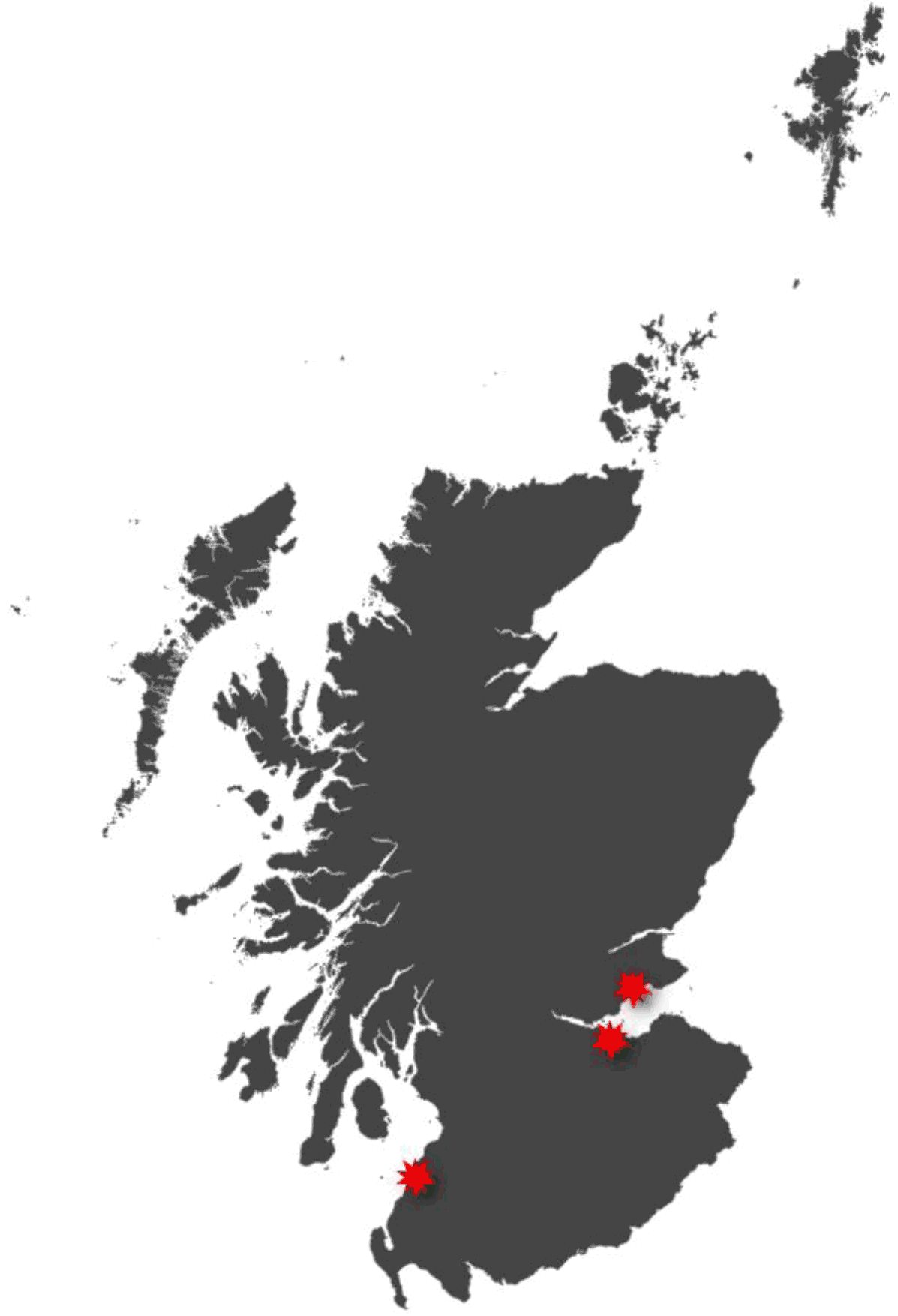
The Industrial Emissions Directive (IED) was written into UK law in 2011. As part of this directive, facilities undertaking certain activities must use Best Available Techniques (BAT) to reduce their pollution emissions. The details of the BAT applied are included in permits issued by competent authorities to the facilities covered by the IED, which also detail the emission limit values applied to the facility. IED activity 6.4 (b)(ii) is "Treatment and processing, other than exclusively packaging, of the following raw materials, whether previously processed or unprocessed, intended for the production of food or feed from only vegetable raw materials with a finished product production capacity greater than 300 tonnes per day or 600 tonnes per day where the installation operates for a period of no more than 90 consecutive days in any year". As with reporting to the UK-PRTR, a Scotch whisky maturation facility would not meet the activity threshold that would require for regulation under the IED.
In addition to the individual permits that industrial facilities may be subjected to, at the planning stage facilities may be required to produce an Environmental Impact Assessment (EIA) if requested to by the local authority (Scottish Statutory Instruments, 2017). In this, both the air quality impacts and climate change impacts should be assessed if they cannot be screened out as being negligible. If the impacts of the development are deemed to be significant through the EIA process, the facility may still be built if the development is considered to still be beneficial to the local community. The Town and Country Planning Regulations (Scottish Statutory Instruments, 2017) list the types of developments which must be subjected to an EIA, which do not include Scotch whisky storage sites. Therefore, it is not mandatory for EIAs to be produced when applications for new bonded warehouses are made to the council. Instead, the requirement for an EIA would be at the local council’s discretion. When EIAs have been produced for new Scotch whisky warehouses, the air quality and climate change impacts are usually deemed to be negligible. However, these assessments do not state a clear methodology for reaching these conclusions.
Another industrial reporting stream is set by the Control of Major Accident Hazards (COMAH) Regulations. These regulations have been established to ensure that businesses take all necessary measures to prevent major accidents if they are dealing with potentially dangerous substances. The high ethanol content in the Scotch whisky maturation barrels makes the maturing liquid highly flammable, and therefore regulated by the COMAH Regulations. All whisky facilities holding a quantity of flammable liquid above 5,000 tonnes must report under COMAH, which equates roughly to all maturation facilities with two or more typically sized bonded warehouses.
As COMAH Regulations concern the quantity of flammable liquid, a distinction will not be made in the database as to whether a listed facility is used for maturation or for bottled storage before export or delivery to other locations in the UK. The bottles in these storage facilities may also include other types of alcohol e.g. gin, wine or beer.
The COMAH database contains information on the procedures in place to reduce the likelihood of a major accident, as opposed to the emissions associated with a given facility. Therefore, the COMAH database has been consulted during this project to review and confirm the locations of Scotch whisky facilities that have already been identified via other reporting mechanisms.
3.2 Data included in the National Atmospheric Emissions Inventory (NAEI)
Data used to inform the Scotch whisky production emissions reported in the NAEI have been obtained from Ricardo, the lead organisation responsible for compiling the NAEI. The data includes the following information about each facility:
- Facility name;
- Facility operator;
- Coordinates of facility location; and
- NMVOC emissions per facility per activity for years 2018, 2019 and 2020.
The activities for which emissions are distributed between are casking, distillation, fermentation, spent grain drying, malting and Scotch whisky maturation. The total emissions for the Scotch whisky industry are derived from figures for the total quantity of whisky in annual statistical reports published by the SWA. However, the SWA has not provided production statistics in recent years and therefore data has been extrapolated by inventory compilers (Ingledew et al., 2023). These total industry emissions are then distributed between each site based on its size relative to the size of the entire sector. However, the relative size of each site is derived from surveys of the industry carried out in the 1990s, mostly from COMAH reporting. In the absence of other subsequent data collection, the production capacity of each facility is assumed to have stayed static since the surveys were collected. Given the rise in Scotch whisky production in recent decades (AQEG, 2020), this is likely to result in inaccuracies in the geographical distribution of emissions as there are no established data flows that inform the Ricardo team of recently built Scotch whisky facilities. This is especially true as the greatest uncertainty is estimated to occur in the emissions from maturation, as new Scotch whisky storage facilities are not easily identified by the Ricardo team. Given that the majority of emissions from Scotch whisky production occur during the maturation process, the uncertainty in the geographical distribution of emissions associated with maturation will have a larger impact on the uncertainty of the emissions distribution from the sector as a whole.
Most sites will not have all activities related to Scotch whisky production occurring on site. Some sites may only have one activity occurring there. For example, out of the 124 sites identified as having Scotch whisky storage on site for the purposes of maturation, 37 of them are sites where only maturation takes place and no other activity. Figure 3 displays all of the Scotch whisky facilities included in the NAEI dataset, colour coded by the types of activities occurring at each site. Of the facilities, 27 of them are only used for Scotch whisky maturation and have no other activities occurring onsite.
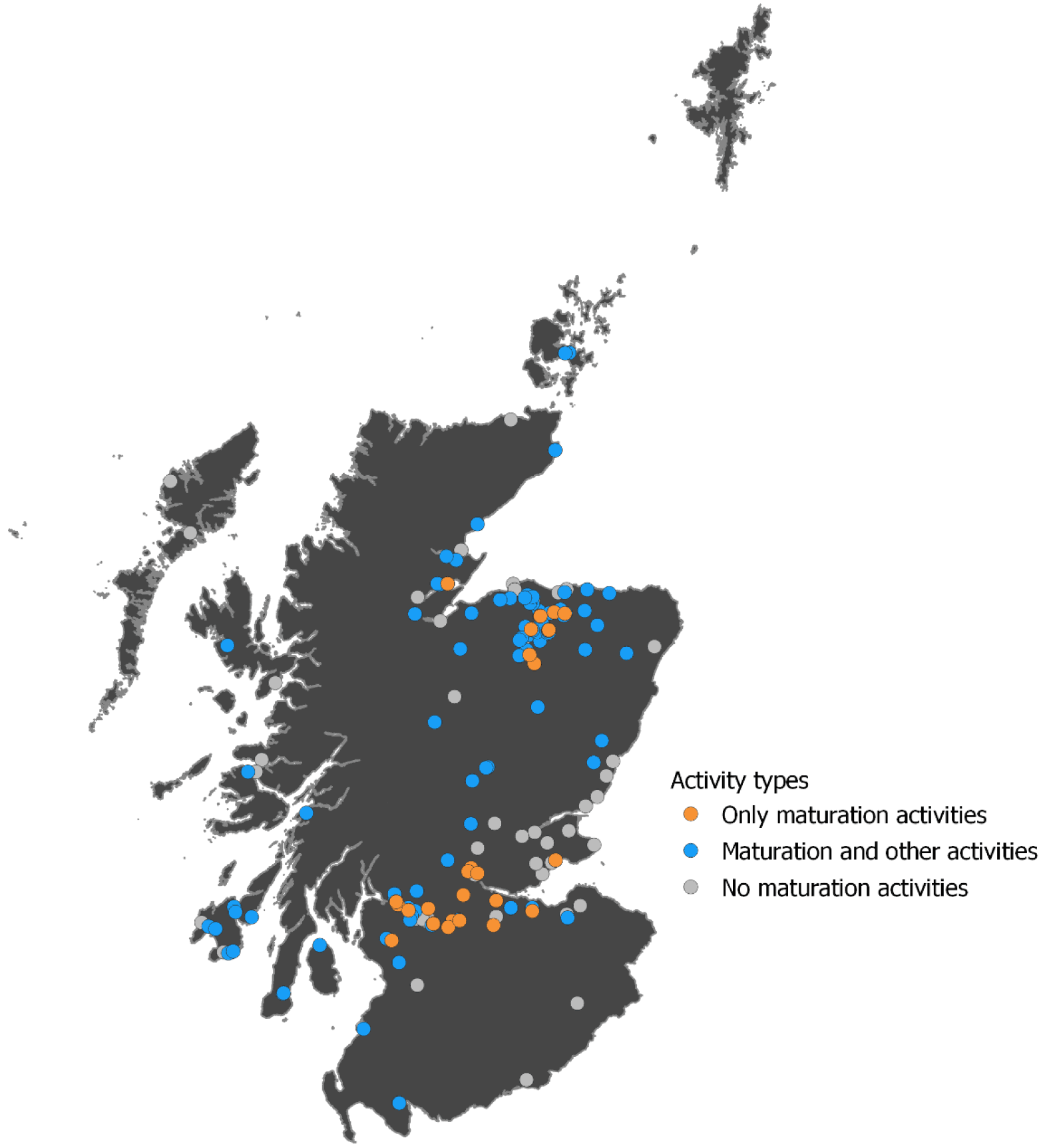
The distribution of NMVOC emissions from the sector between activities is displayed in Table 1 below. The emissions per activity have changed little between 2018 and 2020 for all activities except for Scotch whisky maturation, where emissions are estimated to have increased by 7.1%.
| Activity | 2018 NMVOC emissions (tonnes) | 2019 NMVOC emissions (tonnes) | 2020 NMVOC emissions (tonnes) |
|---|---|---|---|
| Spirit manufacture - casking | 223 (0.3%) | 223 (0.3%) | 223 (0.3%) |
| Spirit manufacture - distillation | 448 (0.6%) | 477 (0.6%) | 477 (0.6%) |
| Spirit manufacture - fermentation | 955 (1.3%) | 954 (1.2%) | 954 (1.2%) |
| Spirit manufacture - Scotch whisky maturation | 67,652 (90.2%) | 70,001 (90.5%) | 72,438 (90.8%) |
| Spirit manufacture - spent grain drying | 1,039 (1.4%) | 1,038 (1.3%) | 1,038 (1.3%) |
| Malting - all | 4,614 (6.2%) | 4,614 (6.0%) | 4,614 (5.8%) |
| Total | 74,931 | 77,307 | 79,744 |
NMVOC emissions from Scotch whisky are not evenly geographically distributed across Scotland. Figure 4 below displays the locations of the Scotch whisky production facilities. There are clusters of sites occurring in Speyside and around Glasgow. Many of the sites are located in rural areas with small local populations. However, there are some sites located within or close to cities and towns within Scotland.
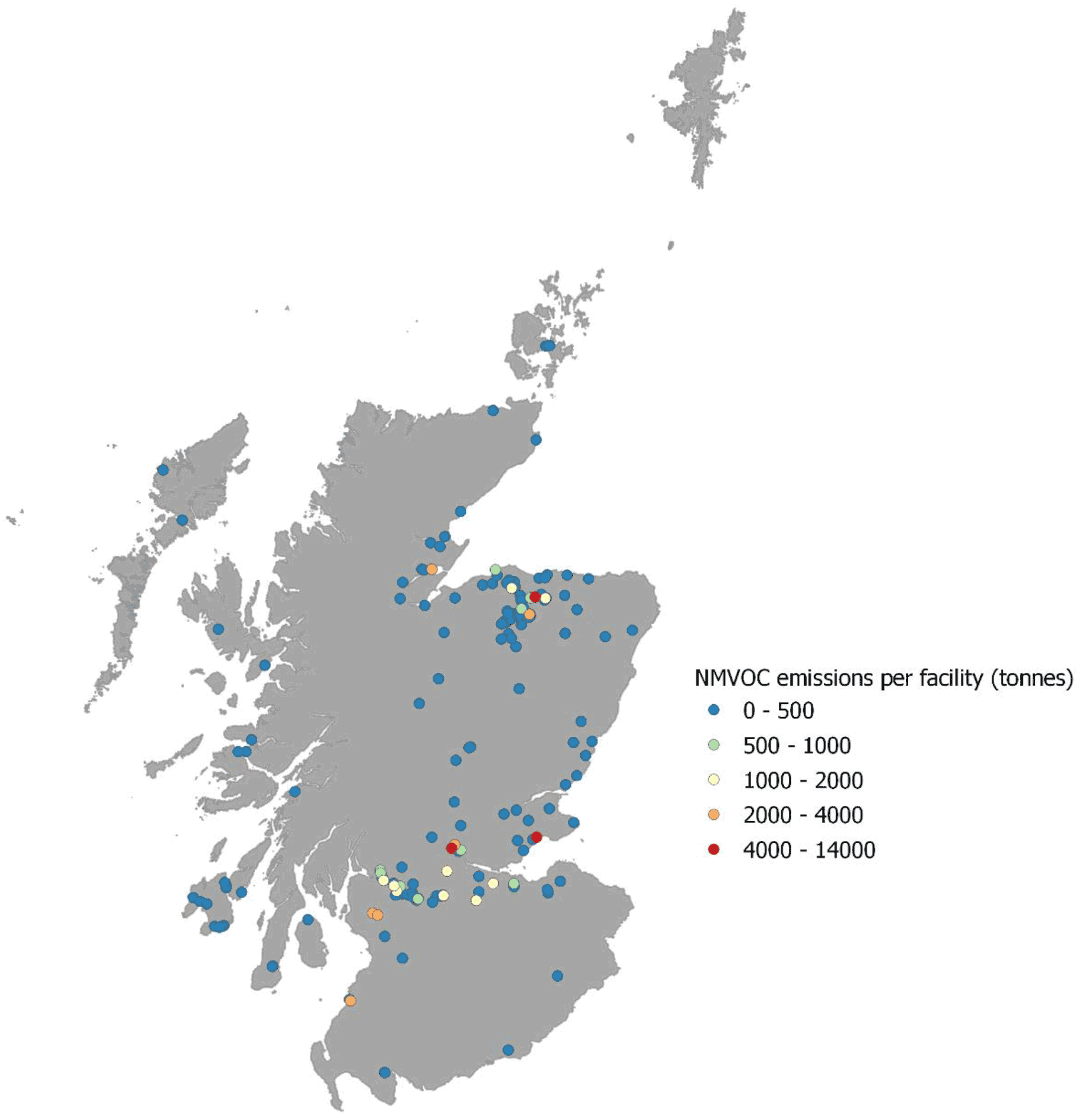
The three facilities undertaking the economic activity ‘Distilling, rectifying and blending of spirits’ which are reported in the UK-PRTR all appear in the NAEI data as Scotch whisky production point sources.
Table 2 displays the NMVOC emissions for 2020 for each site, both in the UK-PRTR (which includes emissions from the production of all spirits, see Section 3.1) and in the NAEI as associated with Scotch whisky. Though there is uncertainty in the per site NMVOC emissions in the NAEI as discussed above, this demonstrates that these facilities are mostly participating in the production of other spirits. As a result, the facilities meet the activity threshold for UK-PRTR reporting.
| Site name | Activities on site | NMVOC emissions reported to the UK-PRTR (tonnes) | NMVOC emissions in NAEI associated with Scotch whisky (tonnes) |
|---|---|---|---|
| North British Distillery | Spent grain drying, fermentation, distillation, casking, Scotch whisky maturation | 6,550 | 26 |
| Cameronbridge | Spent grain drying, fermentation, distillation, casking | 5,930 | 405 |
| The Girvan Distillery | Spent grain drying, fermentation, distillation, casking, Scotch whisky maturation | 6,570 | 3,506 |
The NAEI also provides data for the total NMVOC emissions from all sources within each 1 km by 1 km grid square covering the UK. This data has been aggregated up to a 10 km by 10 km grid covering Scotland. The purpose of the aggregation is to provide a deeper understanding of the local impact of the clustering of multiple Scotch whisky facilities, as many are located within a few kilometres of each other. Additionally, the scale of some of the larger facilities means that the facility is sometimes the only entity within a 1 km by 1 km grid square. The total NMVOC emissions from all sources per 10 km by 10 km grid square is displayed in Figure 5. Most of Scotland is covered by grid cells where the total emissions within that cell totals less than 2,000 tonnes of NMVOC. Indeed, the median total NMVOC emissions per grid cell is 47.0 tonnes. Where there are clusters of Scotch whisky facilities in Speyside, near Stirling, near Glasgow and in central Fife, the total NMVOC emissions for that grid cell is greater. This is particularly true for the 10 km by 10 km grid cell covering land to the east of Stirling which contains four sites (the red grid cell in Figure 5). The total emissions from all anthropogenic sources in this grid cell sum to 18,268 tonnes of NMVOC.
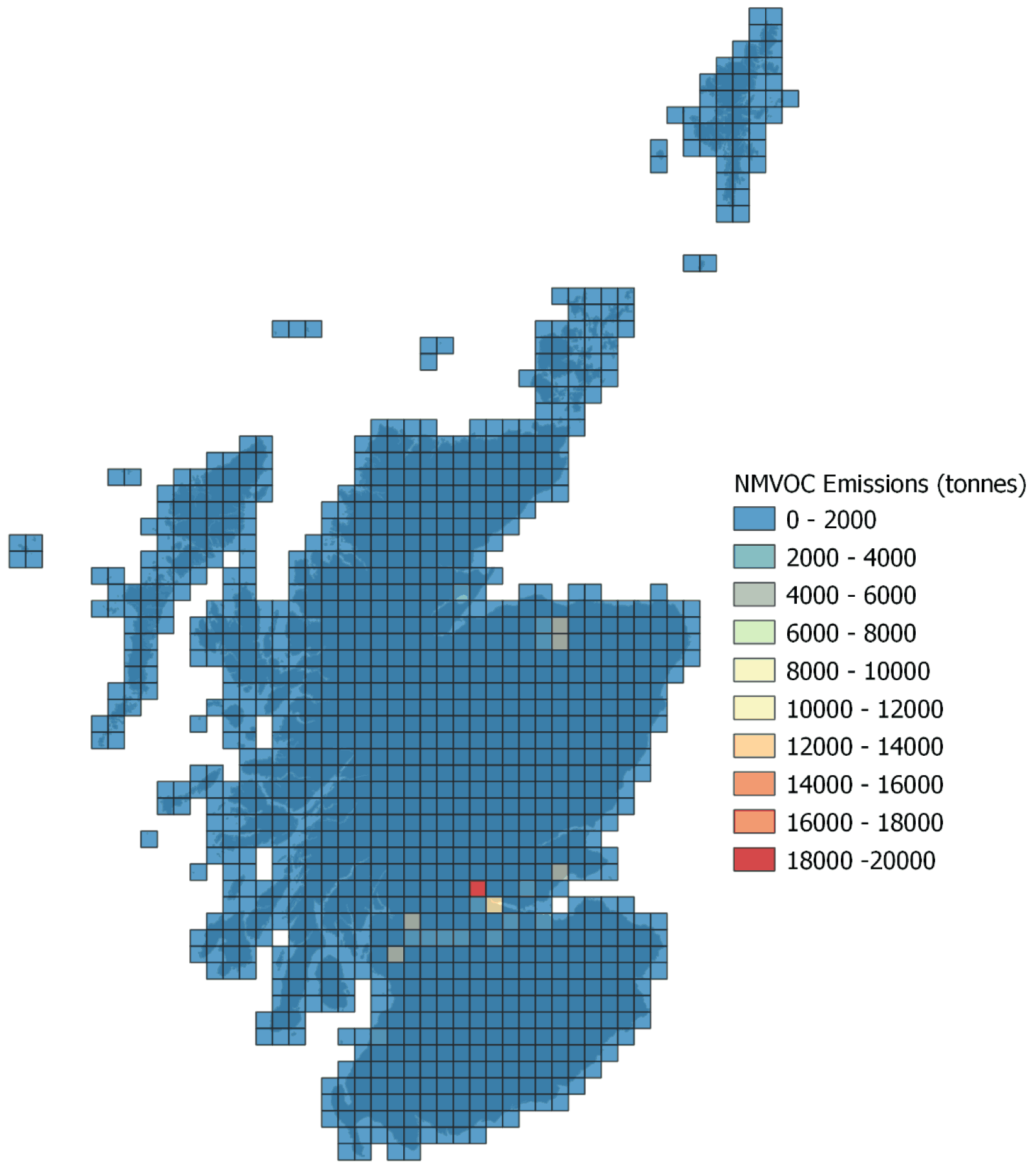
Note: All rights reserved Defra, License number 100022861 (2022) and BEIS License number 100037028 (2022)
There are only two 10 km by 10 km grid cells in Figure 5 for which total NMVOC emissions are above 2000 tonnes and which do not contain Scotch whisky facilities. One of these cells is the grid cell with the second highest total NMVOC emissions from all sources. This cell contains the industrial hub of Grangemouth, to the southeast of Stirling, where a cluster of petroleum product and chemical industry point sources of NMVOCs are located. The other grid cell contains a large chemical industry facility located in west Fife.
Figure 6 displays the total NMVOC emissions from all Scotch whisky facilities that are located within the 10 km by 10 km grid cells used to produce the data shown above. From this figure, the areas with clustering of Scotch whisky facilities can be identified.
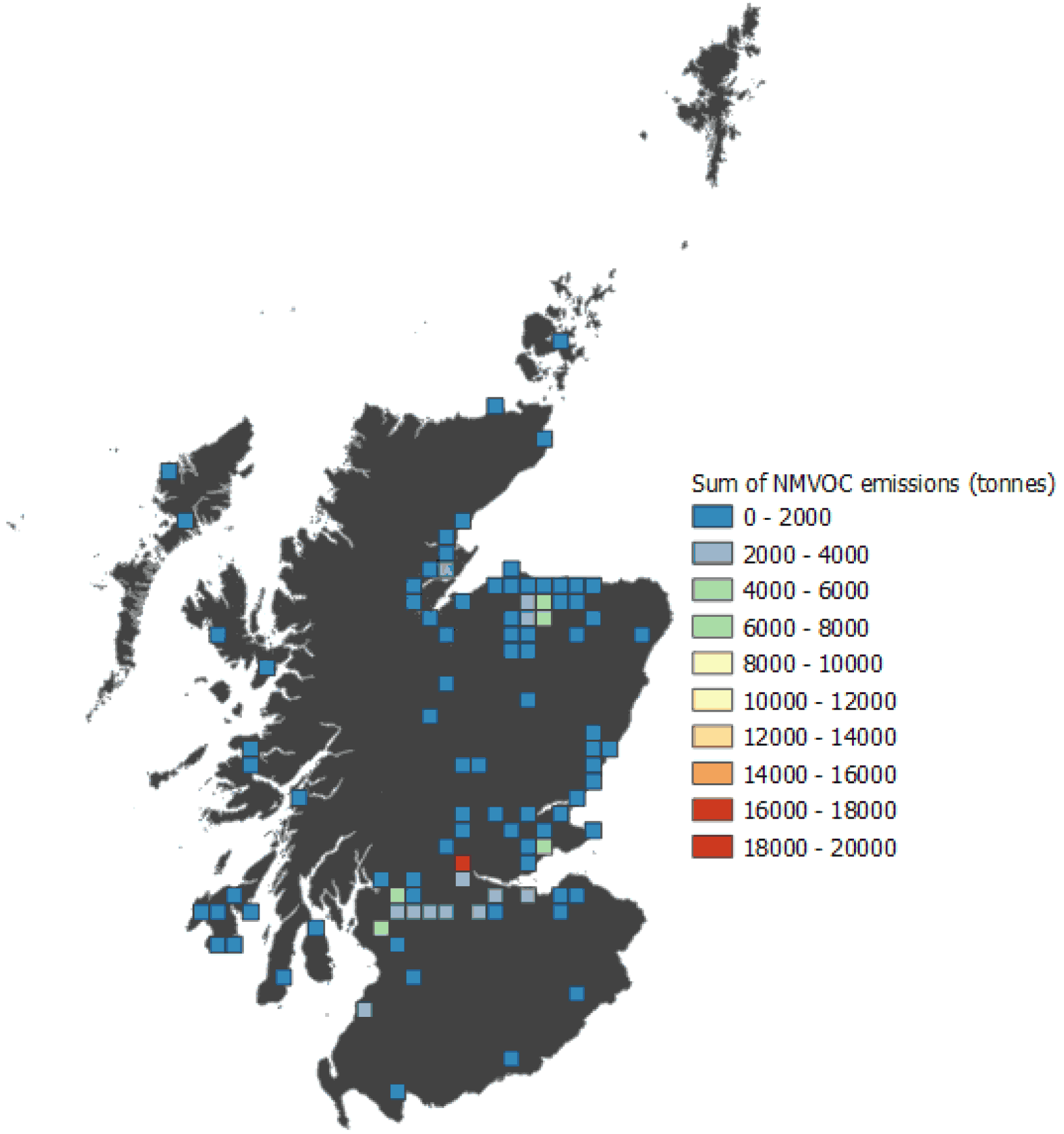
Figure 7 displays how the NMVOC emissions from Scotch whisky production sites contribute to the geographical distribution of total NMVOC emissions. For every 10 km by 10 km grid cell, the NMVOC emissions from every Scotch whisky site located within that grid cell were summed together to give the total NMVOC emissions for the Scotch whisky sector for that grid cell. The total for the sector was then divided by the total NMVOC emissions from all sources in the corresponding 10 km by 10 km grid cell. This provided the spatial distribution of the proportion of the total NMVOC emissions which can be attributed to the Scotch whisky sector.
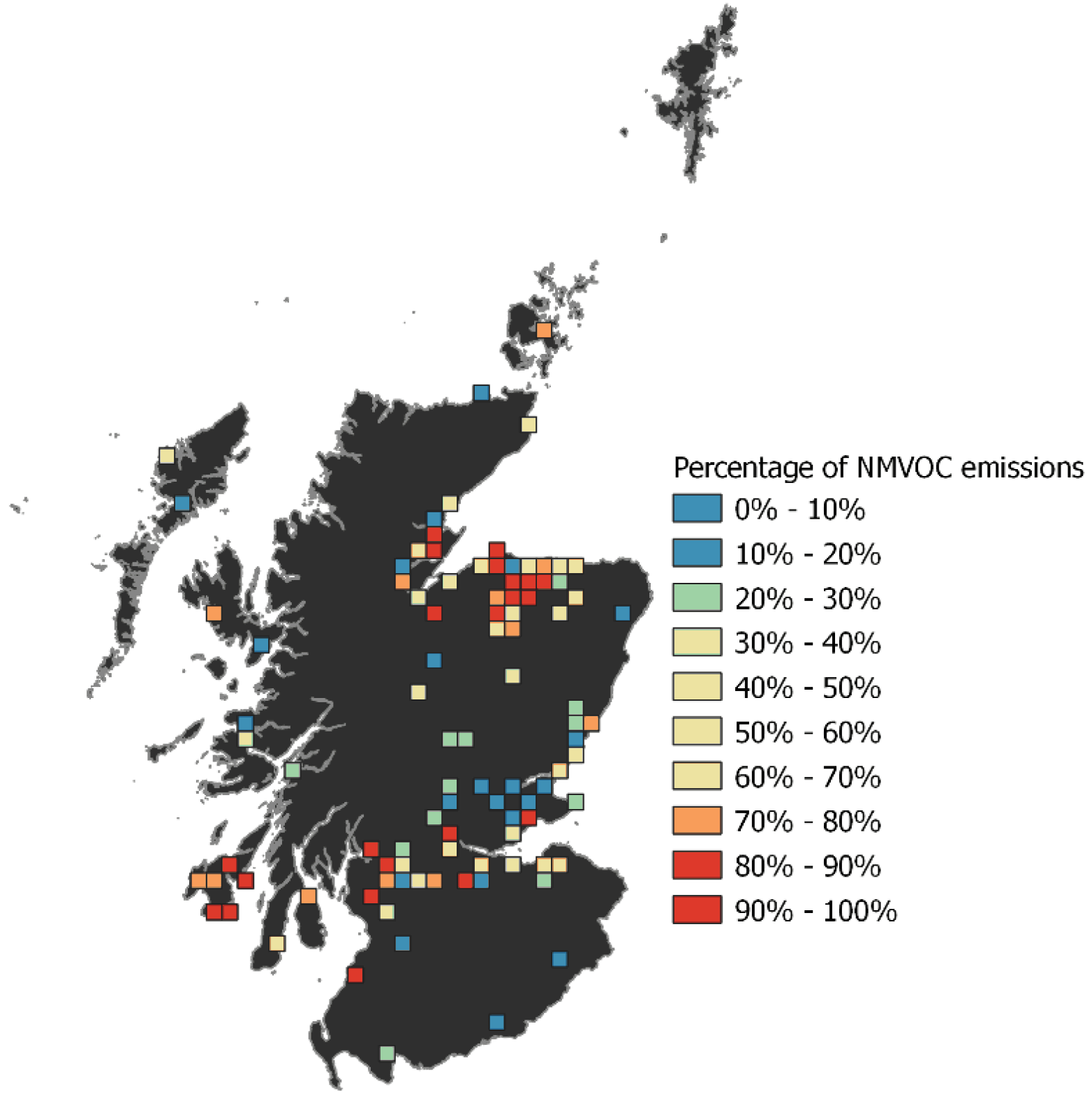
Note: All rights reserved Defra, License number 100022861 (2022) and BEIS License number 100037028 (2022)
At least one Scotch whisky site can be found in 97 of the 1,121 10 km by 10 km grid cells covering all of Scotland, and 39 cells contained at least two sites. Two grid cells, both in Speyside, each contained nine sites involved in the production of Scotch whisky. The Scotch whisky sector was responsible for over 90% of the total NMVOC emissions emitted in twelve of the grid cells (displayed in red on the map in Figure 7). Most of these are located in rural areas where it is not likely that there will be other significant NMVOC sources. However, some are located in more urban environments, where NMVOC emissions are likely to also result from other commercial or domestic activities. The 10 km by 10 km grid cell located to the east of Stirling, and indeed containing the east of the city, is one of these grid cells – 95 % of the NMVOC emissions from sources within this grid cell can be attributed to the Scotch whisky sector. This is also true for the grid cell containing the towns of Methil, Leven and Buckhaven in central Fife, where the proportion of total NMVOC emissions that are due to the Scotch whisky sector is 93%.
It is worth noting that the data provided in the NAEI only provides the total emissions per 1 km by 1 km grid cell, and not the concentrations that residents will be exposed to. The purpose of the NAEI is to provide emissions for international inventory compliance reporting rather than exposure. To determine exposure concentrations, dispersion modelling of ethanol would need to be carried out based upon the spatial distribution of the emissions provided in the NAEI. No such modelling has been published, and therefore there is an inherent uncertainty as to the extent of emission exposure from Scotch whisky. Modelling the dispersion of NMVOCs is complex, as each compound within this category will have a different pattern of dispersion due to compound weight and its propensity to take part in other atmospheric reactions.
The sites vary significantly in their size and therefore also in their estimated NMVOC emissions. Across the 182 sites included in the NAEI, the estimated NMVOC emission per site was 438.2 tonnes per annum on average in 2020. However, the median value was 91.1 tonnes per annum, demonstrating that the average value is skewed by several sites with significantly greater emissions than most sites. The Scotch whisky maturation site emitting the greatest amount of NMVOCs in 2020 was the Blackgrange/Cambus Bonds site located just outside of Stirling in Clackmannanshire at 13,050 tonnes – which is over 8,000 tonnes more than the next largest emitting site, Malcolmburn Warehouse in Moray, Speyside.
Based upon emission rates (emissions per annum), the likely concentrations that nearby sensitive receptors will be exposed to can be estimated using calculations in DEFRA’s Industrial Emissions Screening Tool (DEFRA, 2017). As ethanol is not a pollutant with a set air quality objective, it is not included in this tool. Therefore, to gain insight into the approximate concentrations in the vicinity of Scotch whisky facilities, calculations for 1,3-butadiene have been used instead. Both 1,3-butadiene and ethanol are NMVOCs with a similar number of atoms per molecule. However, dispersion rates and patterns are determined by many factors such as reactivity and energy absorption rates. In this case, the -OH part of the ethanol molecule plays an important part in atmospheric chemical reaction, particularly exhibiting diurnal variations (Grosjean, 1997). Direct comparisons between the molecules should be treated with caution. As a result, there is uncertainty in the concentration estimates, and they are used here only to provide an approximate order of magnitude. The model also treats the emissions as originating from a point source out of a stack. This produces further uncertainty, as ethanol emissions from maturation are not emitted as a point source from a stack, but instead emitted through all façades of a bonded warehouse. Emissions are vented close to ground level and have no additional buoyancy that is associated with hot pollutant plumes from combustion processes. A release height of 3 m was used for these calculations. Concentrations have been estimated at a distance of 100 m from the source, as it represents a typical distance a property or other sensitive receptor may be located from an urban Scotch whisky facility.
Using the median emission rate of 91.1 tonnes per annum for a typical Scotch whisky facility, a concentration of 200 µg/m3 was estimated at a distance of 100 m from the source. For the average emission rate of 438 tonnes per annum, the concentration was 800 µg/m3 at the same distance. If we consider the facility assumed to be emitting the greatest quantity of ethanol per year (13,050 tonnes), the concentrations at 100 m are estimated to be 23,000 µg/m3. These figures can be taken through to estimate dose under exposure scenarios, as discussed in Section 4.1 below. These calculations only provide an order of magnitude estimate of the ethanol concentrations that members of the public are likely to be exposed to close to Scotch whisky maturation sites. They should therefore be treated with caution.
Contact
Email: airquality@gov.scot
There is a problem
Thanks for your feedback